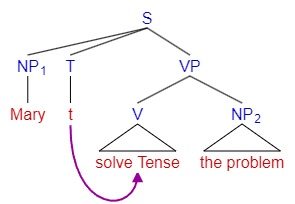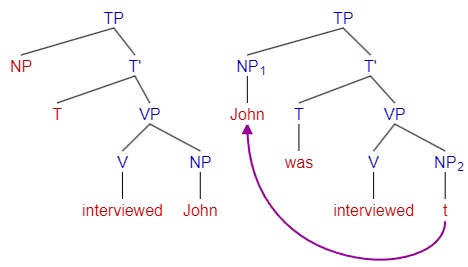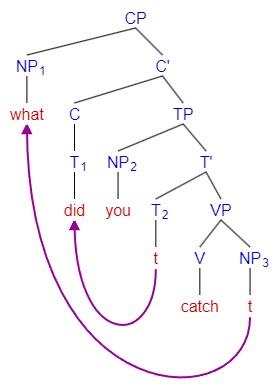Movement
PS rule 的局限性:
- 不能生成一些表示强调的倒装句,比如:\(NP_{2}\ S→NP_2\ NP_1\ Aux\ V\),例句:This problem, I can solve.
- 不能生成 particle movement。生成“bring in the man”很容易,生成“bring the man in”就很难了
- 不能 capture the relatedness of some structures,比如英语中疑问、被动句与陈述句语序的句子应该是有关系的
于是,Chomsky 提出:There is another component - transformation - that co-exists and complements the PS components. 人类的自然语言是唯一存在移位的语言,Baker 说:移位的存在不是出于逻辑上的需要,它深深根植于我们人类语言的性质中
base-generated 基础生成: certain elements in a sentence are generated or derived directly at the initial stage of sentence formation, before any transformations or movement operations take place
Movement operations target both phrasal and terminal categories.
Phrasal movement:
- Wh-movement: Wh-questions, relativization, topicalization
- NP-movement: Passivization, raising
Head Movement
Affix-Hopping
这是个解决句子层面的 tense 具体要跟句中哪个成分结合的理论
观察英语句子中 tense 的分布:
- if no auxiliary, tense shows up on the main verb. e.g. John sings / sang.
- if contains one auxiliary, then it shows the tense. e.g. John will / would sing.
- if contains more than one auxiliary, then tense shows up on the leftmost one. e.g. John will / would have sung.
- each sentence can contain at most one marking for tense
Chomsky's solution: Tense (T) occupies the highest position relative to other predicative terminals. It then lowers to the nearest terminal in the derivation, due to its affixal nature. 即:最基本的句法树是 \([NP_{subject}][T\ Modal\ Aux\ V]\),然后时态会从左到右尝试与句子中的成分结合
e.g. T-to-V Lowering in the Main Verb of "\([_S[_{NP}Mary][_T -ed][_{VP}solve\ the\ problem].]\)"

为什么能确定是 tense 往右与动词结合,而不是 V-to-T Raising 呢?
Diagnotics:尝试在主语和动词中间加一个 VP-adverb,"Mary t cleverly [solve -ed] the problem"。如果是动词移位到 tense 处去和它结合的话,VP-adverb 就应该留在它在句法树上原来的位置,在一维的句子里被挤到 [动词 + Tense] 的后面。法语的动词就是 V-to-T Raising 的,动词为了和 tense 结合,会穿过前面的 VP-adverb。
allomorph 语素变体:will + ed = would, walk + ed = walked, go + ed = went,屈折语中 tense 和其他语素结合时,语素发生形态变化
Do-Support: 被 Neg 阻止了 affix hopping 的否定句,还有疑问句,在 affix-hopping 的规则下没有可以和 tense 结合的成分(动词)来承接 tense,就让助动词 do 上去救场,避免 stranded affix
T-to-C Movement
也称作 Subject-Aux Inversion,一般疑问句(yes/no question)中需要 raise tense to complementizer
"Can Bill solve the problem?" 的解释
- \([_C[+Q][_{TP}Bill[_Tcan][_{VP}solve\ the\ problem]]]\)
- \([_C[_{+Q}Can]_i[_{TP}Bill[_Tt]_i[_{VP}solve\ the\ problem]]]\)
助动词的情况:"Was John at home?"
- derived sentense: \([_{CP}[+Q][_{TP}John[_TTense][_{VP}be\ at\ home]]]\)
- verb raising:\([_{CP}[+Q][_{TP}John[_T[_Vbe]_i\ Tense][_{VP}[_Vt]_iat\ home]]]\)
- T-to-C: \([_{CP}[_{+Q/Aux/C}[_Vbe]_i\ Tense][_{TP}John[_Tt]_i[_{VP}[_Vt]_iat\ home]]]\)
NP Movement
NP-movement refers to a transformation by which an NP lands at an argument, in particular, subject position.
Passive

In the active-passive pair, the semantic relations (argument structure) and the c-selection requirement are the same, but the grammatical functions change. NP-movement in this case is to move the NP object to an empty subject position. This kind of subject is "Object-Subject".
demote/promote 降级/升级:主语变宾语/宾语变主语
Raising
Raising is when the subject of an embedded clause moves to the subject position of a higher clause:
- Expletive (pleonastic) subject: It seems (that) Mary has solved the problem.
- Raised subject: Mary seems to have solved the problem.
Raising Verbs/Predicates:允许出现 raising 的动词,包括 seem、appear、be likely to、be certain to
Infinitive/Finite clause 不定式/定式:whether the main verb in the clause is tensed or non-tensed. Raising is possible only when the embedded clause is infinitival, 即“Mary seems has solved the problem”是不行的,只能是“Mary seems to have solved the problem”
Wh-Movement

A wh-phrase is moved to a specifier in [Spec, C'] to make the sentence interpreted as a special question (特殊疑问句). This is probably the most interesting and important movement.
Wh-move can apply to NP, PP, AP and CP, whereas TP and VP do not undergo wh-movement:
- Which man will David see t?
- Who should John talk to t? (Preposition stranding)
- To whom can John talk t? (Pied-piping)
- How disappointed is Fred t?
- What does Don believe t?
In echo questions, the wh-phrase returns to where the trace was. In multiple questions, only one wh-phrase is moved, and the others leave unchanged. These are how we know where the wh-phrase move from. wh-phrases move from independently needed structural positions associated with particular grammatical functions.
Independently needed “独立必要的”:我的理解是,它们不受其他成分影响,是独立的;但构成特殊疑问句一定需要它们,是必要的
- Echo questions: You talked to WHO?!
- Multiple questions: Which prize did we award to which scientist this year?
Wh-movement can produce unbounded dependency,也就是说 wh-phrase 和 trace 在句法树上的位置可以距离无穷多层成分:I wonder [who Mary believes [(that) Fred knows [(that) I asserted [(that) John saw t]]]]?
C-trace constraint: A filled C is not allowed when adjacent to the trace of a wh-moved subject. e.g. Who did you say [that t likes John]?
一点题外话:Linguists generally think different layers of phrases have different functions:
- VP: domain of the basic argument structure, the layer of semantics
- TP: domain of grammatically functional elements
- CP: discoursal domain. C has the function of clausal typing, defining whether it is a declarative, interrogative or imperative clause.